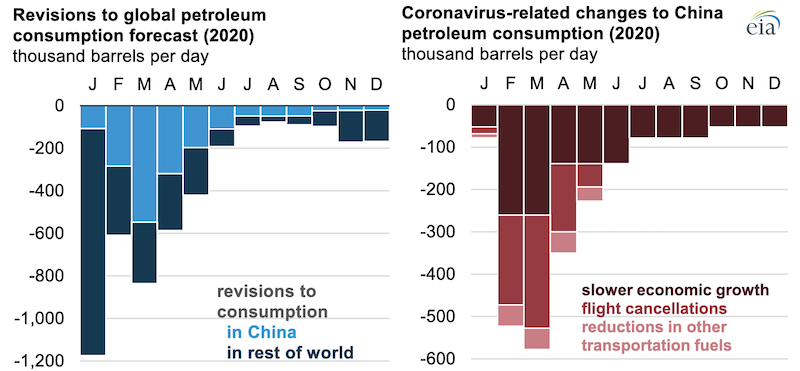In the February 2020 update of its Short-Term Energy Outlook (STEO), the U.S. Energy Information Administration (EIA) forecasts that global liquid fuels demand will average 101.7 million barrels per day (b/d) in 2020, 1.0 million b/d more than the 2019 average but 378,000 b/d less than was forecast in the January 2020 edition of the STEO. The change in the forecast is driven by a combination of lower-than-expected heating fuel consumption caused by the Northern Hemisphere’s warmer-than-expected winter, an expected slowing of economic growth in general, and the particular economic effects of the 2019 novel coronavirus (COVID-19) outbreak.

EIA estimates that COVID-19 will reduce China’s total petroleum and liquid fuels demand by an average of 190,000 b/d in 2020. This forecast is based on estimates of three components:
- The reduction in demand for petroleum and liquid fuels caused by the general decline in Chinese economic activity as measured by gross domestic product (GDP)
- The volume of foregone jet fuel consumption in China caused by flight cancellations
- The additional impact on China’s demand for other transportation fuels
As with any forecast, EIA’s estimates contain a number of uncertainties and limitations. Notably, this forecast is particularly sensitive to the duration of the demand disruption caused by COVID-19. EIA assumes that the timing of COVID-19’s impact on petroleum demand will follow a similar path as the 2003 SARS coronavirus outbreak: demand reductions will intensify in February, peak in March, and steadily decline during April, May, and June. GDP-induced impacts will linger through December.
However, the 2003 SARS coronavirus and COVID-19 have different rates of transmission, detection, and mortality. Consequently, EIA considered the example of the 2003 SARS coronavirus outbreak when estimating duration and peak of the demand impacts, but it did not consider it when estimating the levels of petroleum demand reductions.
Based on estimates from Oxford Economics, economic growth in China will rebound once COVID-19’s impact has faded, and EIA expects petroleum demand to approach the levels forecast in the January STEO near the end of the year. EIA will update its estimates in regular STEO releases.
A more detailed discussion of how EIA estimated the demand revisions appeared in the February 11 This Week in Petroleum.
Principal contributor: Jesse Barnett

Follow us on social media: